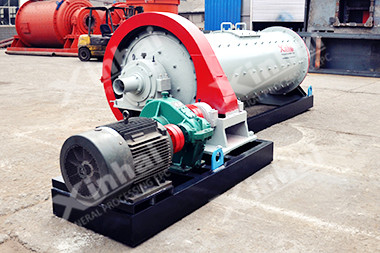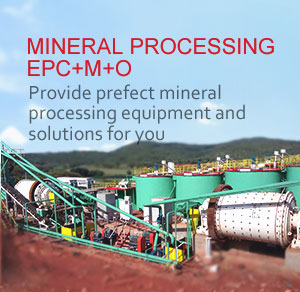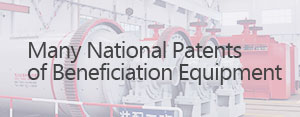- Home
- About
-
Mineral Processing EPC+M+O

Providing optimized solutions for your mine, one-stop service for mineral processing plant!
View details -
Product
- Grinding
- Classifying
Grinding & Classifying
- Flotation
- Gravity Separation Equipment
- Magnetic Equipment
- Gold Extraction Equipment
- Washing Equipment
Separating Process
- Thickening
- Dewatering Machine
Thickening & Dewatering
- Accessories
- Auxiliary Product
Consumables

Xinhai mineral processing equipment mainly include: grinding equipment, flotation equipment, dewatering equipment, magnetic separation equipment, and so on. Some of the equipment is Xinhai independent research and development, and has been awarded national patent. View details
-
Solutions
- Gold Tailings
- Tailings
Tailings

Gold CIP Production Line adsorbs gold from cyaniding pulp by active carbon including 7 steps: leaching pulp preparation, cyaniding leaching, carbon adsorption, gold loaded carbon desorption, pregnant solution electrodeposit, carbon acid regeneration, leaching pulp. View details
- Case
-
News
- Contact
What Is the Difference Between CIP and CIL Gold
2025-06-11 XinHai Views (429)In modern gold extraction technology, the Carbon-in-Pulp (CIP) and Carbon-in-Leach (CIL) processes are the two most widely used cyanidation methods. Although both belong to the category of activated carbon gold adsorption, they are quite different. Their differences include process structure, application scope, and operational efficiency.
What is the difference between CIP and CIL gold? Understanding this question is very important. It helps mining companies optimize design, lower costs, and improve recovery rates.
This article combines real production experience. It explains the process flows, technical principles, and engineering applications of CIP and CIL. It also provides suggestions for choosing the right process. These insights are based on industry expertise and aim to support informed decisions.

I. Overview of the CIP Process: Step-by-Step Operation with Strong Adaptability
CIP (Carbon in Pulp) is a process that extracts gold in two main stages. First, cyanide is used to leach gold from the ore. Then, activated carbon is added to absorb the gold from the solution.
The full process includes crushing, grinding, classification, cyanide leaching, carbon adsorption, desorption electrolysis, and carbon regeneration.
CIP has a clear and separate structure. Leaching and adsorption are done in different tanks. This separation allows for better control of each stage. It is especially suitable for complex ores or ores with high impurity content. For example, it performs well with flotation concentrates, clay-rich oxidized ores, or gravity tailings. With proper control of each section, it can achieve high recovery rates.
However, CIP needs separate leaching and adsorption tanks. This means more equipment and higher upfront investment. It also has a longer operating cycle. Skilled operators are needed to manage the process.

II. Overview of the CIL Process: Simultaneous Operation with Higher Efficiency
CIL (Carbon in Leach) is more streamlined. In this process, activated carbon is added during the cyanide leaching stage. Gold is absorbed by the carbon as soon as it dissolves. Leaching and adsorption happen at the same time.
CIL is simpler than CIP. The slurry goes directly into the leach-adsorption tanks. There is no need for intermediate transfers or repeated separation. This compact process shortens the production time. It also reduces equipment investment and energy use.
CIL is ideal for large gold mines with high-grade ore. It also works well when gold is found together with silver, copper, or other valuable metals. Because the gold is absorbed quickly, it stays in the slurry for less time. This reduces carbon loss and chemical use. As a result, the process is more cost-effective.
However, CIL needs very precise control. Changes in ore composition, pH, or carbon levels can lower recovery efficiency. So, CIL requires quick responses from the technical team. It also needs strong automation systems for real-time control.

III. Key Differences Between CIP and CIL
What is the difference between CIP and CIL gold? Their core differences can be seen in four main areas: process flow, equipment, efficiency, and ore suitability.
1. Process Flow
CIP uses a two-step process: leaching first, then adsorption. This gives flexibility but involves more stages.
CIL combines leaching and adsorption in one tank. It’s a compact and faster process.
2. Equipment and Investment
CIP needs separate tanks for leaching and adsorption. This increases equipment, space, and cost.
CIL uses fewer tanks and more integrated equipment. This reduces initial investment.
3. Efficiency and Resource Use
CIL is faster and uses fewer reagents and less carbon. It suits large-scale, continuous operations.
CIP is more flexible but slower. It is better for processes that need frequent adjustments.
4. Ore Suitability
CIP is best for complex ores with unstable grades or high impurities.
CIL is ideal for high-grade, stable ores in large, steady-supply projects.
IV. Key Considerations When Choosing a Process
Choosing a process is not just about chasing higher efficiency. Companies should consider several key factors:
Ore Grade and Stability
If the ore quality varies a lot, use CIP. If the ore is high-grade and stable, choose CIL.
Project Size and Production Mode
For large-scale and continuous production, CIL is more suitable. For small-scale or varied input, CIP is better.
Environmental and Regulatory Requirements
Both methods use cyanide. A proper system for waste treatment and liquid recycling is essential.
Workforce and Automation
CIL needs better automation and real-time monitoring. CIP requires experienced operators to manage each stage carefully.
V. Conclusion: Match the Process Based on Ore Characteristics
CIP and CIL each have their strengths. Mining companies should start with a clear understanding of ore characteristics. They must also consider their own resources, environmental goals, and technical capacity.
A scientific match between the ore and the gold extraction process is key. Knowing **what is the difference between CIP and CIL gold** helps in making smart decisions.
Looking ahead, gold extraction will become greener and smarter. New technologies such as cyanide-free methods and intelligent mining will emerge. Traditional CIP and CIL processes will evolve. They will include automation, AI optimization, and eco-friendly materials. These changes will bring new energy to the gold mining industry.
copper mining
... [more]
Chrome Wash Plants: Science, Cost & Regional Insights
... [more]
Related Article
- Gold Mining Equipment Introduction
- Comprehensive Guide to Gold Wash Plants
- Gold CIP Process: Principles, Flowsheet, Plant Design, and Best Practices
- Gold Heap Leaching: Technical Insights, Operational Strategies, and Future Directions
- How is Gold Processed Step by Step
- Gold Ore Beneficiation: Advancing Efficiency and Sustainability
- Gold Mining Equipment Costs: A Down-to-Earth Guide
- Gold Ore Gravity Separation Equipment
- Comprehensive Analysis of CIP in Gold Processing
- Affordable Gold Ore Processing Practical Guide for Growing Enterprises
Mineral Processing EPC
Solutions
CONTACT US
- Tel: 0086 15901320633
- Fax: 0086 10 59621207
- Email: mhxu@xinhaimining.net
© 2017 Shandong Xinhai Mining Technology & Equipment Inc. Technical Support: Beijing Xinhulian Technology Co., Ltd.
Factory Address: No. 188, Xinhai Street, Fushan high-tech industrial development district, Yantai, Shandong, China






